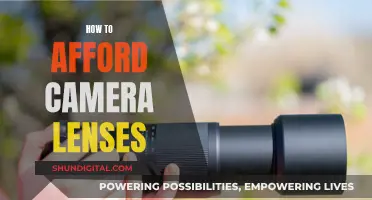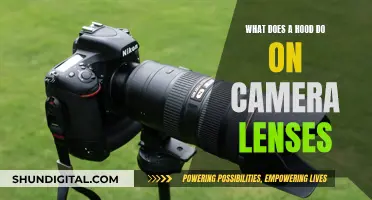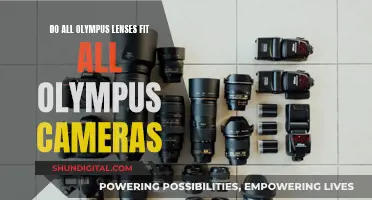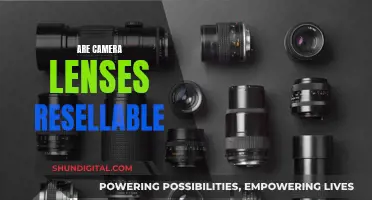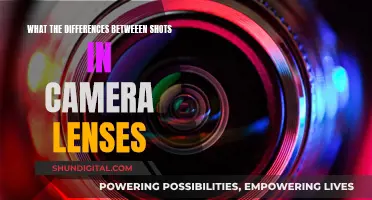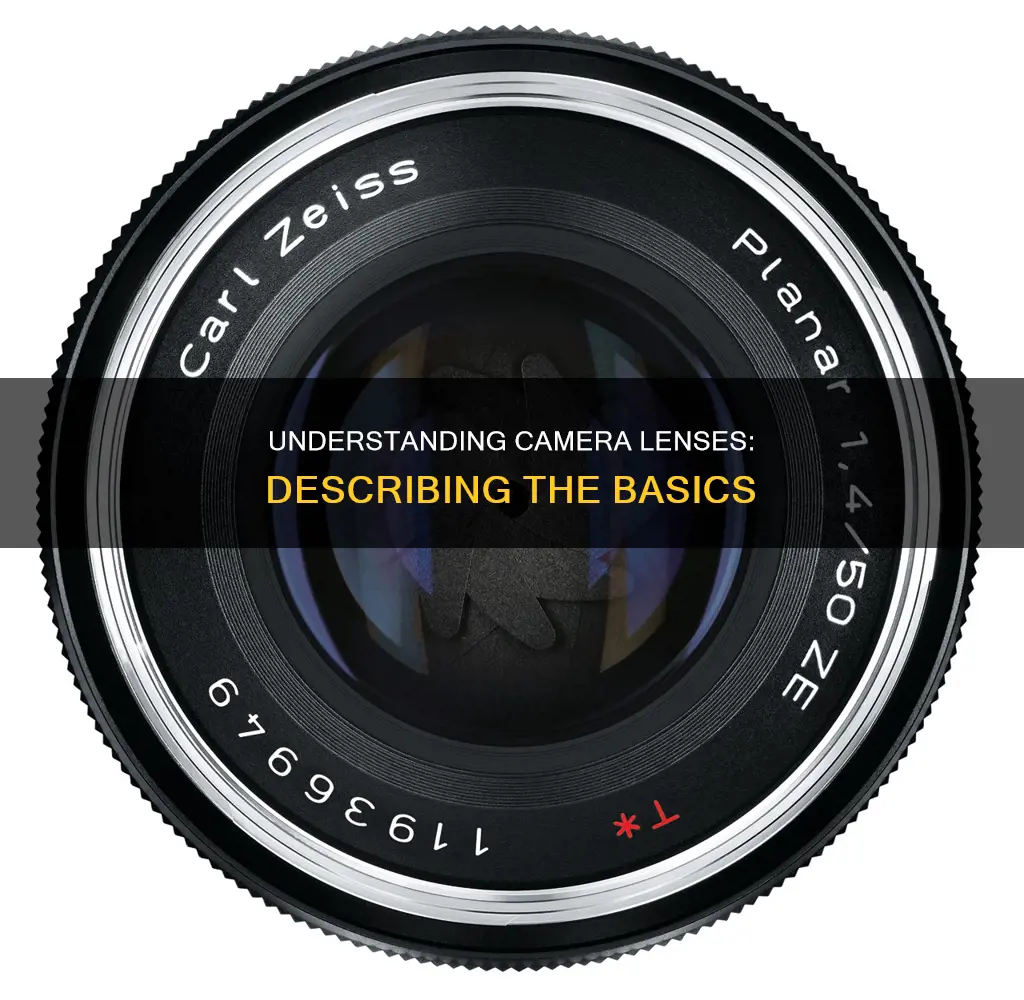
Camera lenses are an essential part of a photographer's kit, with the potential to vastly improve image quality. A camera lens is an optical body that features a single lens or an assembly of lenses that mounts to a camera body. Some lenses are built into the camera, while others are interchangeable. Lenses are described using a range of terms, including focal length, aperture, depth of field, and lens speed.
The focal length of a lens determines its angle of view and how much the subject will be magnified. Wide-angle lenses have short focal lengths, while telephoto lenses have longer ones. Lenses with a shorter focal length are known as wide-angle lenses, while those with a longer focal length are called telephoto lenses.
The aperture of a lens controls how much light enters the lens and is measured in f-stops or t-stops. A larger aperture, or wider opening, lets in more light and gives a shallower depth of field.
Depth of field refers to how much of the image is in focus. A shallow depth of field will give a blurred background, while a large depth of field will keep everything in focus.
Lens speed refers to the maximum aperture of a lens and is important for low-light photography. A lens with a larger maximum aperture will be faster and let in more light.
| Characteristics | Values |
|---|---|
| Focal length | 14mm – 35mm (Wide Angle Lens), 35mm – 70mm (Standard), 70mm – 200mm (Telephoto Lens) |
| Aperture | f-number, f-stops, t-stops |
| Depth of field | Shallow or deep |
| Lens type | Zoom, Prime, Macro, Telephoto, Wide-angle, Fisheye, Tilt-shift |
| Lens elements | Multiple lens elements grouped together |
| Lens mounts | Screw mounts, lock ring, bayonet fitting |
What You'll Learn

Focal length
The focal length of a lens also determines what your camera can focus on and how your images will turn out. It dictates what part of the image is in focus, and how much of the scene will be captured. A longer focal length will give a narrower image that is closer to the subject, whereas a wider lens will capture more of the area from further back.
There are two types of lenses: prime and zoom. Prime lenses have a fixed focal length, whereas zoom lenses have variable focal lengths. Zoom lenses are more versatile and convenient as you can carry just one lens that can be used in a range of shooting situations. However, prime lenses are often smaller and lighter, and can offer better optical quality and larger apertures.
Understanding Camera and Lens Lifespan by Shot Count
You may want to see also

Aperture
In addition to affecting exposure, aperture also influences the depth of field. Depth of field refers to the amount of the photograph that appears sharp from front to back. A larger aperture creates a shallow depth of field, resulting in a blurred background with a beautiful shallow focus effect. This is commonly used in portrait photography to bring attention to the subject. On the other hand, a smaller aperture yields a greater depth of field, keeping both the foreground and background in sharp focus. Landscape photographers often utilise this effect.
The choice of aperture depends on the desired artistic effect and the type of scene being captured. For instance, in portrait photography, a larger aperture is typically used to blur the background and emphasise the subject. In landscape photography, a smaller aperture is generally preferred to achieve a wider depth of field, ensuring that both the foreground and background are in focus.
Do Camera Lenses Have an Expiry Date?
You may want to see also

Zoom vs. prime lenses
Zoom lenses and prime lenses are two types of camera lenses with distinct characteristics and advantages. While zoom lenses offer versatility and convenience, prime lenses provide superior image quality, faster apertures, and compactness. Here is a detailed comparison between the two:
Zoom Lenses:
- Versatility and Convenience: Zoom lenses offer a variable focal length, allowing photographers to easily switch between wide-angle and telephoto perspectives without physically moving. This makes them ideal for situations where movement is restricted or when a diverse range of shots is required, such as in wildlife or landscape photography.
- Image Stabilization: Many modern zoom lenses are equipped with image stabilization technology, enabling photographers to capture sharp images even in low-light conditions. This feature is particularly useful for non-moving subjects.
- Weight and Portability: Zoom lenses tend to be heavier and bulkier than prime lenses, especially those with a large focal range. This can be a consideration when travelling or shooting for extended periods.
- Optical Quality: Creating a zoom lens with consistent optical quality across its entire focal range is challenging. While technological advancements have improved their performance, they may not match the sharpness and clarity of prime lenses, especially at extreme focal lengths.
- Aperture: Zoom lenses typically have smaller maximum apertures, resulting in a narrower depth of field and less "bokeh" (background blur). This can limit their low-light performance and creative capabilities.
Prime Lenses:
- Image Quality: Prime lenses are renowned for delivering exceptional image quality. They often produce sharper images with better optics, making them ideal for photographers seeking the highest resolution and detail.
- Faster Apertures: Prime lenses offer wider apertures, such as f/1.2 or f/1.4, which provide superior low-light performance and a shallower depth of field. This allows for beautifully blurred backgrounds and enhanced subject separation, making them excellent for portrait photography.
- Compactness and Weight: Prime lenses are generally smaller and lighter than zoom lenses, making them more portable and comfortable to use. They usually have fewer optical components, contributing to their compact design.
- Cost-Effectiveness: Prime lenses often provide superior optical quality at a lower price point compared to zoom lenses. Photographers on a budget can access world-class optics without compromising image quality.
- Creative Constraints: Prime lenses force photographers to "zoom with their feet," encouraging them to move closer or farther from their subjects to compose their shots. This physical aspect of shooting can lead to new discoveries, enhance composition skills, and foster a more deliberate approach to framing.
In conclusion, the choice between a zoom lens and a prime lens depends on the photographer's needs and preferences. Zoom lenses offer the convenience of multiple focal lengths in one lens, while prime lenses provide superior image quality, faster apertures, and compactness. Budget, shooting style, and desired level of versatility are essential factors to consider when making a decision.
Lens Compatibility: Can You Mix and Match Brands?
You may want to see also

Lens mounts
A lens mount is a mechanical and sometimes electrical interface between a camera and a lens. It allows cameras to have interchangeable lenses. Lens mounts are also used in optical equipment that doesn't involve a camera, such as modular components used in optical laboratory prototyping.
The size of the lens mount is an important factor in a camera system. A larger mount size allows for larger lenses that can provide more light to the sensor, enabling the design of faster lenses. However, a larger throat diameter also means larger and heavier lenses.
Different camera manufacturers (such as Sony, Nikon, and Canon) typically have incompatible lens mounts. This is often due to proprietary designs, with variations in the mechanical and electrical interfaces, as well as the flange focal distance. This incompatibility can be a challenge for photographers when choosing lenses and adapting them to different camera bodies.
Lens mount adapters are available to attach lenses from one camera system to another. However, these adapters may have limitations, such as a loss of autofocus or electronic communication between the lens and camera.
Handcrafted Zeiss Lenses: Precision and Artistry in Optics
You may want to see also

Lens markings
Camera lenses have a variety of markings that can be confusing to beginners. Here is a detailed explanation of the most common markings found on camera lenses:
Focal Length Numbers:
Focal length numbers are usually found next to the zoom ring on the lens. They indicate the range of focal lengths the lens can cover. For example, a 70-200mm zoom lens can zoom from 70mm to 200mm. Prime or fixed lenses, on the other hand, have a single focal length marked on the lens barrel, such as 50mm or 85mm.
Maximum Aperture:
The maximum aperture is the largest aperture opening the lens can achieve. It is usually written on the end of the lens barrel or on the front of the lens inside the filter ring area. It is represented as f/2.8, f/22, etc., where a smaller f-number corresponds to a wider aperture. Larger apertures are desirable as they allow shooting in low-light conditions with a fast shutter speed.
Focusing Range and Distance Scale:
Some lenses have a distance scale marked in feet and meters, indicating the distance at which the lens is focused. One end of the scale represents the infinity symbol, while the other end represents the minimum focusing distance. As you adjust the focus, the distance scale changes to reflect the new point of focus.
Lens Diameter and Filter Size:
The lens diameter is the distance across the center of the lens, usually marked on the end of the lens with a symbol like a zero with a strike-through. This diameter corresponds to the filter size, and you need to use filters with the same diameter for them to properly screw onto the front of the lens.
Aperture Ring:
Older lenses or some modern manual focus lenses have an aperture ring that allows you to set different aperture settings by rotating the ring. This feature is less common on newer lenses, as most modern lenses control the aperture through the camera.
Hyperfocal Distance Scale:
Prime lenses, especially older models, may have a hyperfocal distance scale that helps determine the depth of field for a scene given the focal length, point of focus, and aperture. The hyperfocal distance scale uses the distance scale to display the expected depth of field. By focusing the lens and setting the aperture, you can find the corresponding near and far depth of field limits on the scale.
Lens Version:
Some lenses indicate the version with a number or letter, such as "II" for the second version of a lens model. This means it has the same focal length and maximum aperture as the previous version but with improved features.
Image Stabilization Technology:
Image stabilization technology is indicated by different abbreviations depending on the lens brand. For example, Canon uses "IS" for Image Stabilization, Nikon uses "VR" for Vibration Reduction, and Tamron uses "VC" for Vibration Compensation.
Focusing Motor Type:
Higher-end lenses may have markings indicating the type of focusing motor, such as USM (Canon), SWM (Nikon), or HSM (Sigma). These motors are often called silent wave motors and are advertised as being faster and quieter than standard focusing motors.
Full Frame vs. Crop Sensor:
Filter Diameter Symbol:
The diameter of the lens may be marked using the diameter symbol "Ø", followed by the value in millimeters. This information is useful when purchasing filters, as the filter diameter must match the lens diameter.
Asurion: Cracked Camera Lens Coverage and Claims
You may want to see also
Frequently asked questions
A camera lens is an optical body that features a single lens or an assembly of lenses that mounts to a camera body.
Zoom lenses and prime lenses. Zoom lenses have variable focal lengths, while prime lenses have a fixed focal range.
Wide-angle lenses, telephoto lenses, macro lenses, tilt-shift lenses, and fisheye lenses.


